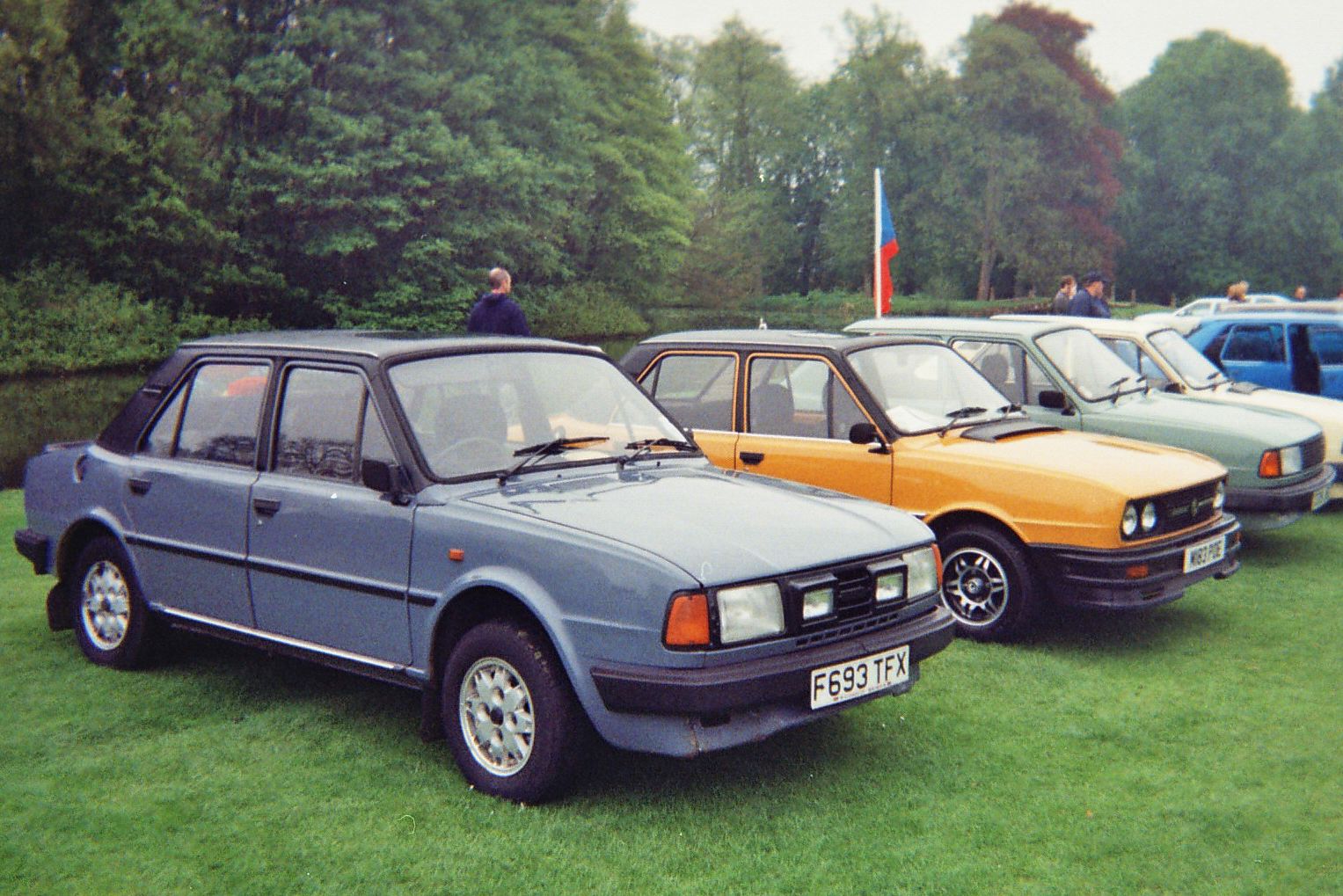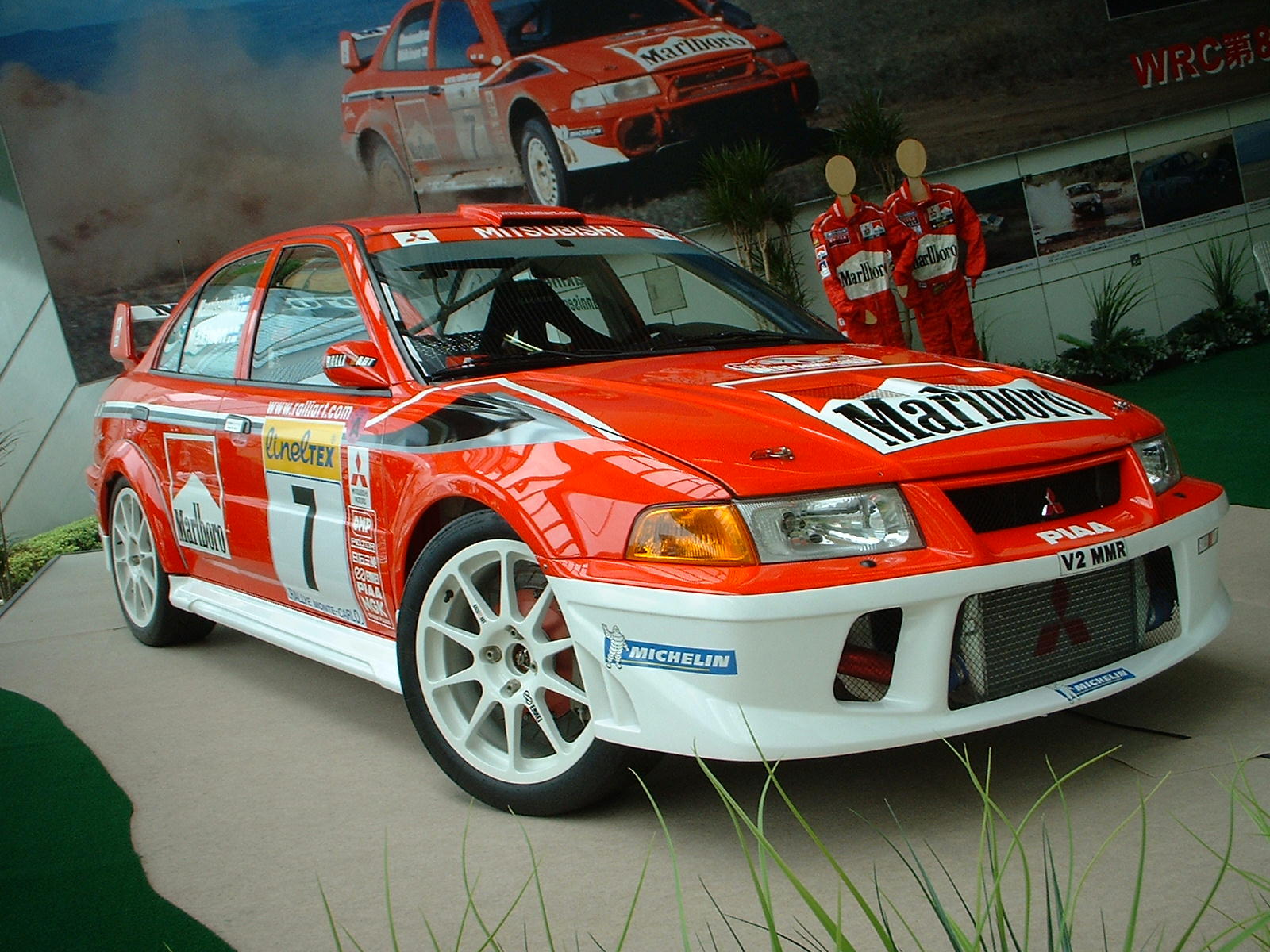|
Å koda 130
The Å koda 130, Å koda 135 and Å koda 136 are three variations of a rear-engined, rear-wheel drive small family car that was produced by Czechoslovakian car manufacturer Å koda Auto, AZNP in MladĂ¡ Boleslav, Czechoslovakia between 1984 and 1990. The Å koda 130 is known internally as Type 742, and the Å koda 135/136 as Type 746. They were developed from the Å koda 105/120 series. Introduction The very first Å koda 130 models were introduced in August 1984, shortly after the earlier Å koda 105/120 models were given a mild revamp. Developed from the earlier Å koda 105/120 models (some of which continued in production alongside the Å koda 130 models), the 130 series used a new 1289 cc engine (which produced , and which was just an enlarged version of the 1174 cc engine used in the 120 series). The 130/135/136 series also had a five-speed gearbox, semi-trailing arm rear suspension, wider track and four-pot front brake disc calipers (the latter two of which were already in use in the ... [...More Info...] [...Related Items...] OR: [Wikipedia] [Google] [Baidu] |
Rear-engined
In automobile design, a rear-engine design layout places the engine at the rear of the vehicle. The center of gravity of the engine itself is behind the rear axle. This is not to be confused with the center of gravity of the whole vehicle, as an imbalance of such proportions would make it impossible to keep the front wheels on the ground. Rear-engined vehicles almost always have a rear-wheel drive car layout, but some are four wheel drive. This layout has the following features: *Packaging: since there is no need for a transmission tunnel, the floor can be flat. *Rear traction: having the engine located over the driven wheels increases downward pressure, which is helpful for grip on loose surfaces, although can be prone to oversteer. *Simplicity of manufacture: the engine is near the driven wheels, and the transmission can be merged with the differential to save space. This layout was once popular in small, inexpensive cars and light commercial vehicles. Today most car makers have ... [...More Info...] [...Related Items...] OR: [Wikipedia] [Google] [Baidu] |
Kvasiny
Kvasiny (German: ''Kwasney'') is a municipality and village in Rychnov nad Kněžnou District in the Hradec KrĂ¡lovĂ© Region of the Czech Republic. It has about 1,500 inhabitants. Economy Kvasiny is home to the Volkswagen Group-owned Å koda Auto factory A factory, manufacturing plant or a production plant is an industrial facility, often a complex consisting of several buildings filled with machinery, where workers manufacture items or operate machines which process each item into another. T .... References Villages in Rychnov nad Kněžnou District Company towns {{HradecKralove-geo-stub ... [...More Info...] [...Related Items...] OR: [Wikipedia] [Google] [Baidu] |
Cars Powered By Rear-mounted 4-cylinder Engines
A car or automobile is a motor vehicle with wheels. Most definitions of ''cars'' say that they run primarily on roads, seat one to eight people, have four wheels, and mainly transport people instead of goods. The year 1886 is regarded as the birth year of the car, when German inventor Carl Benz patented his Benz Patent-Motorwagen. Cars became widely available during the 20th century. One of the first cars affordable by the masses was the 1908 Model T, an American car manufactured by the Ford Motor Company. Cars were rapidly adopted in the US, where they replaced animal-drawn carriages and carts. In Europe and other parts of the world, demand for automobiles did not increase until after World War II. The car is considered an essential part of the developed economy. Cars have controls for driving, parking, passenger comfort, and a variety of lights. Over the decades, additional features and controls have been added to vehicles, making them progressively more complex. Th ... [...More Info...] [...Related Items...] OR: [Wikipedia] [Google] [Baidu] |
Straight-four Engine
A straight-four engine (also called an inline-four) is a four-cylinder piston engine where cylinders are arranged in a line along a common crankshaft. The vast majority of automotive four-cylinder engines use a straight-four layout (with the exceptions of the flat-four engines produced by Subaru and Porsche) and the layout is also very common in motorcycles and other machinery. Therefore the term "four-cylinder engine" is usually synonymous with straight-four engines. When a straight-four engine is installed at an inclined angle (instead of with the cylinders oriented vertically), it is sometimes called a slant-four. Between 2005 and 2008, the proportion of new vehicles sold in the United States with four-cylinder engines rose from 30% to 47%. By the 2020 model year, the share for light-duty vehicles had risen to 59%. Design A four-stroke straight-four engine always has a cylinder on its power stroke, unlike engines with fewer cylinders where there is no power stroke occu ... [...More Info...] [...Related Items...] OR: [Wikipedia] [Google] [Baidu] |
Overhead Valve
An overhead valve (OHV) engine, sometimes called a ''pushrod engine'', is a piston engine whose valves are located in the cylinder head above the combustion chamber. This contrasts with earlier flathead engines, where the valves were located below the combustion chamber in the engine block. Although an overhead camshaft (OHC) engine also has overhead valves, the common usage of the term "overhead valve engine" is limited to engines where the camshaft is located in the engine block. In these traditional OHV engines, the motion of the camshaft is transferred using pushrods (hence the term "pushrod engine") and rocker arms to operate the valves at the top of the engine. Some early intake-over-exhaust engines used a hybrid design combining elements of both side-valves and overhead valves. History Predecessors The first internal combustion engines were based on steam engines and therefore used slide valves. This was the case for the first Otto engine, which was first succ ... [...More Info...] [...Related Items...] OR: [Wikipedia] [Google] [Baidu] |
Oversteer
Understeer and oversteer are vehicle dynamics terms used to describe the sensitivity of a vehicle to steering. Oversteer is what occurs when a car turns (steers) by more than the amount commanded by the driver. Conversely, understeer is what occurs when a car steers less than the amount commanded by the driver. Automotive engineers define understeer and oversteer based on changes in steering angle associated with changes in lateral acceleration over a sequence of steady-state circular turning tests. Car and motorsport enthusiasts often use the terminology more generally in magazines and blogs to describe vehicle response to steering in a variety of maneuvers. Vehicle dynamics terminology Standard terminology used to describe understeer and oversteer are defined by the Society of Automotive Engineers (SAE) in document J670SAE International Surface Vehicle Recommended Practice, "Vehicle Dynamics Terminology", SAE Standard J670, Rev. 2008-01-24 and by the International Organization ... [...More Info...] [...Related Items...] OR: [Wikipedia] [Google] [Baidu] |
Porsche 911
The Porsche 911 (pronounced ''Nine Eleven'' or in german: Neunelfer) is a two-door 2+2 high performance rear-engined sports car introduced in September 1964 by Porsche AG of Stuttgart, Germany. It has a rear-mounted flat-six engine and originally a torsion bar suspension. The car has been continuously enhanced through the years but the basic concept has remained unchanged.Corlett, p. 12 The engines were air-cooled until the introduction of the 996 series in 1998. The 911 has been raced extensively by private and factory teams, in a variety of classes. It is among the most successful competition cars. In the mid-1970s, the naturally aspirated 911 Carrera RSR won world championship races including Targa Florio and the 24 Hours of Daytona. The 911-derived 935 turbo also won the 24 Hours of Le Mans in 1979. Porsche won the World Championship for Makes in 1976, 1977, 1978, and 1979 with 911-derived models. In a 1999 poll to determine the Car of the Century, the 911 was fifth. I ... [...More Info...] [...Related Items...] OR: [Wikipedia] [Google] [Baidu] |
Cabriolet (automobile)
A convertible or cabriolet () is a passenger car that can be driven with or without a roof in place. The methods of retracting and storing the roof vary among eras and manufacturers. A convertible car's design allows an open-air driving experience, with the ability to provide a roof when required. A potential drawback of convertibles is their reduced structural rigidity (requiring significant engineering and modification to counteract the effects of removing a car's roof). The majority of convertible roofs are of a folding construction framework with the actual top made from cloth or other fabric. Other types of convertible roofs include retractable hardtops (often constructed from metal or plastic) and detachable hardtops (where a metal or plastic roof is manually removed and often stored in the trunk). Terminology Other terms for convertibles include cabriolet, cabrio, drop top, drophead coupé, open two-seater, open top, rag top, soft top, spider, and spyder. Consistenc ... [...More Info...] [...Related Items...] OR: [Wikipedia] [Google] [Baidu] |
Skoda Estelle
Å koda means ''pity'' in the Czech and Slovak languages. It may also refer to: Czech brands and enterprises * Å koda Auto, automobile and previously bicycle manufacturer in MladĂ¡ Boleslav ** Å koda Motorsport, the division of Å koda Auto responsible for motorsport activities * Å koda Transportation, engineering company that manufactures rail vehicles, based in Plzeň * Å koda Works, engineering company, predecessor of Å koda Transportation * Doosan Å koda Power, subsidiary of the Doosan Group, based in Plzeň People * Å koda (surname) * Skoda (Portuguese footballer) (born 1960) Art * ''Å koda lĂ¡sky'', the original Czech title of the "Beer Barrel Polka" Other * British Rail Class 90, an electric locomotive nicknamed Skoda * ''Skoda'' (barquentine), sailing vessel built in Kingsport, Nova Scotia, in 1893 * Skoda Xanthi F.C., former name of the Greek football club Xanthi F.C. (sponsored by Å koda Auto in 1991–2016) ** Skoda Xanthi Arena, former name of the club's stadium * S ... [...More Info...] [...Related Items...] OR: [Wikipedia] [Google] [Baidu] |
Group A
Group A is a set of motorsport regulations administered by the FIA covering production derived vehicles intended for competition, usually in touring car racing and rallying. In contrast to the short-lived Group B and Group C, Group A vehicles were limited in terms of power, weight, allowed technology and overall cost. Group A was aimed at ensuring numerous entries in races of privately owned vehicles. Group A was introduced by the FIA in 1982 to replace the outgoing Group 2 as "modified touring cars", while Group N would replace Group 1 as "standard touring cars". During the early years there were no further formula for production based race cars. Cars from multiple Groups could contest the World Rally Championship for Manufacturers for example until 1997 when the specific World Rally Car formula was introduced as the only option. In recent years Groups A and N have begun to be phased out in eligibility in championships though they continue to form the homologation basis for mos ... [...More Info...] [...Related Items...] OR: [Wikipedia] [Google] [Baidu] |
Group B
Group B was a set of regulations for grand touring (GT) vehicles used in sports car racing and rallying introduced in 1982 by the Fédération Internationale de l'Automobile (FIA). Although permitted to enter a GT class of the World Sportscar Championship alongside the more popular racing prototypes of Group C, Group B are commonly associated with the international rallying scene during 1982 to 1986 in popular culture, when they were the highest class used across rallying, including the World Rally Championship, regional and national championships. The Group B regulations fostered some of the fastest, most powerful, and most sophisticated rally cars ever built and their era is commonly referred to as the golden era of rallying.''Top Gear'' websiteThe corner that killed Group B However, a series of major accidents, some fatal, were blamed on their outright speed with lack of crowd control at events. After the death of Henri Toivonen and his co-driver Sergio Cresto in the 1986 To ... [...More Info...] [...Related Items...] OR: [Wikipedia] [Google] [Baidu] |





.jpg)


